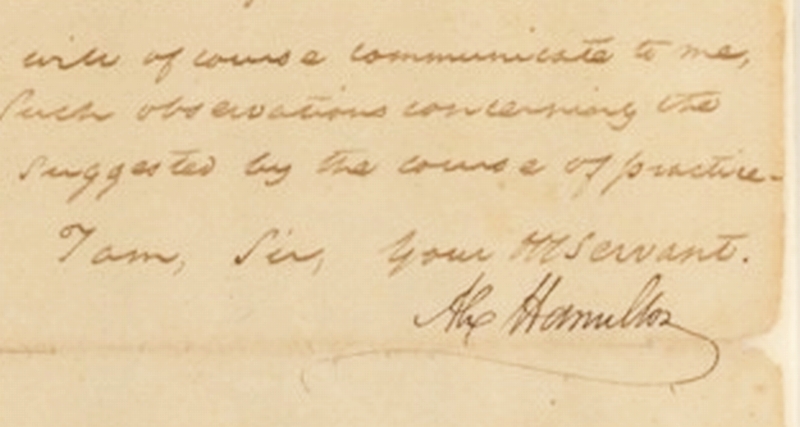
With Cruzan Rum contributing close to $100 million a year in federal excise-tax rebates to the local government and construction well underway at Diageo’s Captain Morgan distillery, the document is a reminder of the very old and ongoing rum trade between St. Croix and the U.S. mainland. And it is one more concrete, if small, example of the many ties between Hamilton and St. Croix, the island where the founding father spent his teenage years.
For more than 30 years, the document was held by the U.S. Bureau of Alcohol, Tobacco, Firearms and Explosives.
"The letter is apparently the first document that told customs agents how to assess taxes on imported alcohol," said ATF historian Barbara Osteika on Monday. Another historian speaking about the significance of the document brought up this fact during a ceremony conferring the document to the National Archives on Thursday, she said.
The document will become part of the permanent holdings of the National Archives and will be preserved in a locked, temperature- and humidity-controlled stack area in its College Park, Md., facility.
The document, dated Dec. 18, 1790, and signed by Hamilton, is a circular letter distributed to the customs agents of the United States, with specific instructions on how to use a hydrometer to get consistent alcohol content measurements. Interestingly, U.S. law of 1790 had a specific tariff just for St. Croix rum.
"It may serve to aid the offices to be informed that the first of the class of the proof mentioned in the law corresponds with gin, the second with St. Croix rum," Hamilton wrote, continuing, "the third with Antigua rum, the fourth with Jamaica spirits, the fifth with the usual strength of high wines and the sixth or last with what is called alcohol."
Taxing imported rum was a major milestone in early U.S. history, giving the new federal government a source of revenue with which to pay its debts.
"Treasury Secretary Hamilton’s letter is one of the foundation documents of ATF,"
said acting Archivist of the United States Adrienne Thomas in accepting the document. "It is also an important piece of American history, because the policies laid out in the circular contributed to one of the earliest challenges to the new government."
The early history of this circular remains a mystery, but it was discovered in the mid-1970s by ATF Public Information Officer Howard Criswell Jr., according to statements from the ATF and the National Archives. Criswell collected autographs as a hobby and came across the letter in a catalogue from an autograph dealer in New York City. He purchased it for about $100, intending to use the letter for an ATF bicentennial exhibit.
It remained in a safe until 1979, when another ATF employee discovered it and suggested it be placed on display. Because of concerns that prolonged exposure to light would fade the document, the circular was placed back in safekeeping, where it remained until it was rediscovered by ATF employees during a relocation of its headquarters building in 2005.
At the end of the American Revolution, the national government owed $37 million dollars in debt, a figure dwarfed by the $114 million owed by the states. At Hamilton’s urging, the federal government assumed responsibility for the debt of the states. One of the first attempts by Congress to reduce the national debt was the Tariff of 1789, which placed duties on the import of distilled spirits, among other items. Quickly realizing that these duties were not generating enough revenue, Congress passed a higher tariff in 1790.
In an early example of tax policy affecting the business world, Americans reacted to the duties on imported liquor by increasing domestic production of alcoholic beverages. So, in response, Hamilton petitioned Congress for another act in 1791, taxing spirits produced inside the United States, as well. This promptly led to a violent tax revolt, known to history as the Whiskey Rebellion. Enraged citizens demonstrated in several cities, and a number of federal agents were harassed and threatened.
The rebellion ended in 1794, when a large federal force convinced the protesters to return to their homes. This revolt was the first test of power of the new federal government, establishing its authority in disputes with individual states.
Hamilton’s letter is a vital piece of that historic legacy.
Born as a British subject on the island of Nevis in 1755, Hamilton arrived on St. Croix in May 1765 with his mother, Rachael Faucette Lavian, and brother James. They had been on St. Croix less than a year when Alexander, as an 11-year-old boy, took a job as a clerk at the Beekman and Cruger store in Christiansted. Right now, the National Park Service is in the midst of a study to decide whether Estate Grange, a home associated with Alexander Hamilton’s childhood on St. Croix, should become part of the park system.





